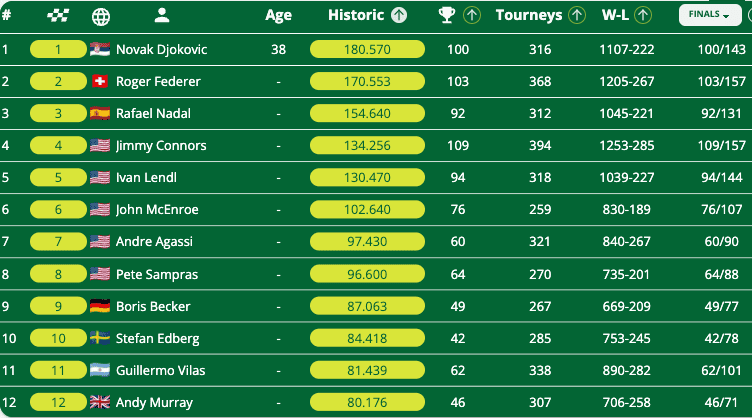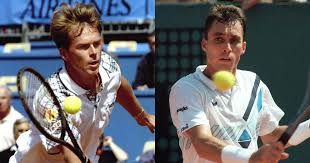A dominant Sinner wins his second consecutive ATP Finals title, securing his second Invincible TRH title (90.63% win rate). Alcaraz finishes a fantastic 2025 as the world number one.
Sinner and Alcaraz are making rapid progress in the Tennis History Race. 2025 has been a great year for both.
# | Age | Historic | Tourneys | W-L | ? |
|---|

Identifying the Greatest Tennis Player of All Time While others focus only on final victories, we consider an entire career. Nowadays, several approaches are used to determine who the 'GOAT' of Tennis is. Most rely on who has captured the most Grand Slams, Nitto ATP Finals (Masters Tournament), and Masters 1000, the highest number of weeks at number one in the ATP Rankings, or the most seasons ended in the top spot. Another widely used measure is the total number of tournaments or matches a player has won.
The question we ask is: Who is the all-time greatest tennis player? And, what is the most effective method to determine this? Typically, various methodologies are considered to decide who the TENNIS GOAT (Greatest Of All Time) is.
The most typical measure is the player with the most Grand Slam victories.
The count of major tournament victories (majors), namely Grand Slams, Finals (Masters Tournament), and Masters 1000, is also commonly used.
Another popular metric is the number of weeks a player holds the No. 1 spot in the ATP Rankings.
Weeks within the Top 5, 10, 100... of the Ranking.
The tally of titles won.
The number of matches won throughout a career.
The winning percentage over matches played, and likewise for sets, games, points, etc.
And many more, which subjectively combine these aspects.
Indeed, the sports world, particularly in tennis, is rich in statistics.
All these metrics are valid for gauging success in specific areas from each person’s subjective viewpoint.
Mostly, these methods share a common flaw: they only consider title winners and not the entirety of each player's career, i.e., tournaments where they were finalists, semi-finalists, quarter-finalists, etc.
Moreover, many rankings that mix various scoring types, though wisely calibrated, end up repeatedly evaluating the same data, essentially each match played. Logically, the player who has clinched more titles has won more matches, accumulated more points, secured higher rankings, etc.
Truly, winning a match or tournament sometimes hinges on luck, particularly when victories are by narrow margins, among other factors.
And deciding who is the best, or the greatest, is also somewhat a matter of semantics.
Since tennis, like all sports, is fundamentally about outplaying the opponent, the best is undeniably the one who secures the best outcome, regardless of the means. Whether it was a direct result of their gameplay or other elements played a part.
However, if other aspects are valued, such as technique, strategy, tactics, determination, intelligence, or class, the notion of the best or the greatest might not align with the final outcome, though it often closely correlates over time.
Let me use an undisputed example from another sport, football. How often has it been agreed that one team was superior to another, played better, yet lost a match or a championship: The outcome was unfair.
Yet, when reviewing all the games or championships a team has participated in over a season or era, it's apparent that injustices largely balance out. But, for greater fairness, we should assess and weigh all performances, not just those that decided a championship. Our method strives to achieve this.
In our view, to evaluate any player’s full career trajectory as thoroughly and objectively as possible, each game and each opponent faced should be scored just once.
In the early days of the Open era, when the ranking system was established, scoring was based on the opponent faced, a method later abandoned due to the difficulty in assessing and updating it.
However, this website proposes a method that somehow leads to globally similar conclusions and results as if each match were assessed based on the opponent.
This method adopts the scoring system currently used by the ATP Ranking for each tournament type, albeit with some adjustments.
Thus, the value of matches is determined by the tournament category and the level of the opposing players, which, to a great extent, directly correlates with each phase or round of the tournament, which is completely logical.
One could debate the value of each tournament and the scoring for each phase, but in truth, the ATP's current scoring system is well-established and broadly accepted within the tennis community.
That is why we have opted for it as our foundation. And we are convinced that any other logically designed scoring system would lead to very similar conclusions.
The data has been readily available since 2009 with the inception of the current scoring system. However, for the period before 2009, when the scoring system was different, it has been necessary to standardize the matches and tournaments to fit the current system.
This has been an exhaustive task, and the outcome will undoubtedly differ from other rankings, but it represents another way to measure tennis players' performances, akin to their lifelong tennis marathon, without excluding other methods.
Although the concept might seem straightforward at first glance, despite our searches, we are not aware of any prior use of this valuation method with its unique features, which adds novelty value.
A similar outcome can be derived by taking the ATP Ranking score at the end of each year. The result would likely not vary significantly from our method, but this simpler approach would not allow for the development of the search capabilities that this website offers nor encompass periods prior to the establishment of the current Ranking.
Additionally, this method has several drawbacks, such as not including all tournaments, only the 18 or 19 that are scored, awarding points for weeks not played due to injury, and during the pandemic, a point maintenance system was introduced that skewed the year-end rankings.
Some of these conditions may be suitable for a short- to medium-term ranking intended to select participants for certain tournaments but not for a historical ranking.
Matches from the Grand Slams, Finals, Masters 1000, ATP 500, and ATP 250 in individual tournaments and their equivalents have been considered.
And for women's tournaments, the corresponding WTA 1000, WTA 500, and WTA 250.
Matches from lesser tournaments, below the T-250 range (equivalent to ATP 250 and WTA 250), the preliminary qualifying rounds, Challengers, Futures, or junior and lower category tournaments are not included.
In team tournaments, Davis Cup matches are included, though for scoring purposes, only the final phases (R16-QF-SF-F) of the World Group are counted.
Also included are the Billie Jean King Cup (formerly Federation Cup), United Cup, ATP Cup, ATP World Team Cup, Nations Cup, and Laver Cup.
The database comprises over 120,000 player records, 16,000 tournaments, and 350,000 matches, each with multiple fields that together accumulate millions of data values.
General criteria for standardizing men's tournaments
A great variety of tournament formats have been identified. Beyond the traditional knockout (KO) setups, numerous variations exist: round robin stages can feature single or multiple groups with varying numbers of participants. Subsequent phases might include a direct final, or progress through semifinals and even quarterfinals. Some tournaments also implement a double round robin. The draw sizes range broadly from 128 to just 2 competitors (128, 96, 80, 64, 56, 48, 32, 20, 16, 12, 10, 9, 8, 7, 6, 5, 4, and 2).
The vast majority have been by the KO system, with draws of 128, 64, and 32, with or without Bye. In the ATP Era (1990-2025) almost all, 100%, except the Finals are KO type with Draw 128, 64, and 32. In the OPEN Era up to the ATP Era (1968-1989), approximately 87%.
Criteria for standardizing tournaments of the ATP Era (1990-2025)
The equivalences are very clear, as there have been no notable changes from 2009 to today and in the period 1990-2009 the equivalent categories are assumed by the ATP itself.
The Grand Slams (up to 2,000 points) have not varied over time.
The equivalents of the current ATP Finals (2017-2023) (up to 1,500 points) are the ATP World Tour Finals (2009-2017), Tennis Masters Cup (2000-2008), Grand Slam Cup, and ATP Tour World Championships (1990-1999).
The equivalents of the current ATP Tour Masters 1,000 (2019-2023) (up to 1,000 points) are the ATP World Tour Masters 1000 (2009-2018), ATP Masters Series (2004-2008), Tennis Masters Series (2000-2003), ATP Super 9 (1993-1999), and Championship Series Single Week (1990-1992)
The equivalents of the current ATP World Tour 500 (2009-2023) (up to 500 points) are the ATP International Series Gold (2000-2008) and ATP Championship Series (1990-1999).
The equivalents of the current ATP Tour 250 (2009-2023) (up to 250 points) are the ATP International Series (2000-2008) and ATP World Series (1990-1999).
The Olympic Games are scored the same as in the most recent ones held, Tokyo 2020 (up to 750 points).
Team Tournaments
The different historical scoring systems have been considered, adapting them to the current reality. They are scored up to a maximum of 500 points.
Criteria for standardizing tournaments prior to the ATP Era (1968-1990) with "Pure Knockout (KO)" formats and draw 128, 64, and 32”.
Assignment of equivalent categories to the Grand Slams, Masters 1000, ATP 500, and ATP 250 (T-1000, T-500, and T-250):
The Grand Slams are considered to have had no variation over time, so they are always valued at up to 2,000 points.
During the reference period, the categories of the main circuits, Grand Prix, and WCT, were determined by the amount of prize money, which has been considered almost entirely.
The Grand Prix circuit had a classification system with multiple variants that varied practically every year. The different categories have been equated, by adapted tranches, to the current T-1000, T-500, and T-250.
In the years when the number of T-1000 or T-500 was excessive or scarce, different criteria are used to obtain a coherent categorization. These are the main ones:
Criteria for scoring tournaments prior to the ATP Era with formats other than "Pure Knockout (KO) and draw 128, 64, and 32”.
In general, the vast majority of these tournaments do not reach the 250 or 500 point score, are not categorized as T-1000, T-500, and T-250. They are included in a category of special tournaments called "Others". These are the main criteria:
The size of the draw is the main factor determining the maximum tournament score.
Number of matches won needed to win the tournament, to achieve the maximum score: as a general rule, fewer than five victories implies fewer than 250 points.
To categorize the years 1968 and 1969, when the Grand Prix did not exist and the WCT tournaments had draws of 8 and 9 mainly, the criterion of the Draw and the continuity of the category assigned to the tournament is taken.
Having a loss may prevent the maximum score, even if the tournament is won, as occurs with tournaments with round robin, like the current Masters Finals.
Special Events score less, despite their economic amount, since many players were invited, almost always the same.
Standardization of Women's Tournaments
The current WTA model is adhered to.
The Grand Slams (up to 2,000 points) have remained consistent over time.
The equivalents to the current WTA Finals (WTA Championships 1990-2024) (up to 1,500 points) include the Virginia Slims Championships 1972-1978, Colgate Series Championships 1977-78, Avon Championships 1979-82, and Toyota Series Championships 1981-82.
The equivalents to the WTA Elite Trophy (2015-19, 2023) (up to 700 points) are the WTA Tournament of Champions (2009-14) and the Grand Slams Cup (1998-99).
The predecessors of the current WTA 1000 (up to 1,000 points) are the Premier Mandatory (2009-19), Premier 5 (2009-2020), and Tier 1 (1988-2008).
The predecessors of the current WTA 500 (up to 500 points) are the Premier (2009-20) and Tier 2 (1988-2008).
The predecessors of the current WTA 250 (up to 250 points) are the International (2009-20) and Tier 3, Tier 4, and Tier 5 (1988-2008).
For earlier seasons (1968-87), the different and varied classifications of each year, the economic amount of the prizes of each tournament, and the size of the draw were considered for tournaments equivalent to WTA 1000, WTA 500, and WTA 250, as well as special tournaments.
The Olympic Games are scored as in the most recent, Tokyo 2020 (up to 750 points).
The system allows selection through drop-down menus and movable pointers for the following options:
Ranking of the greatest tennis players in history by viewing a comprehensive table, with various sorting options: Score (according to this method), Tournaments won, Matches won. It also features a dropdown to display the rounds reached in the tournaments played.
Selection, via a scroll bar, by variable time periods or a specific year.
Filtering of players by: name, country, player's hand (right-left handed), career up to a specific age, according to current age, and whether active or retired.
Selection by tournaments, distinguishing them by name, category, individual or team, and type of surface.
It also provides a tool for viewing the progression of players' careers over time through mobile graphics of two types, as a horizontal bar chart or as a polygonal line.
Particularly useful for making comparisons and races between players and for visualizing in a single mobile image their performance in a particular tournament over time.
Data is derived from a blend of our own archives and external publications:











